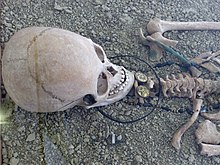Avar grave
A Awarengrab is an archaeological grave - reference , which the historian insights into the Avars can give and their time. In written records, not much more than ten Avars are known by name, whereas the Hungarian archaeologist István Bóna (1930–2001) estimates that over 50,000 Avar graves have been excavated in over 2,000 sites.
A multitude of conclusions can be drawn from the burial rites, additions of food, traces of illness and injuries and other findings from the often rich graves. Important warriors were buried with their rich costume and weapons, often even with their horses. The horses were often burned at the grave and the remains were buried, but the whole horse was buried just as often. The women were often given rich jewelry in their graves.

In the early days, the graves were oriented in an east-west direction, probably towards sunrise. Later the orientation changed for no apparent reason in a south-east-north-west direction. For this purpose, archaeologists and historians have created a large number of theories, without any agreement on a plausible explanation so far.
Body burial was common to the European Avars. In the early days, the dead were usually placed in coffins. Depending on social status, the effort ranged from tree coffins in large, deep pits, which give the impression of a resting place lovingly furnished as living space, to simple board coffins that were only buried moderately deep. The dead were also given meat additions of various sizes with them on the last journey. The graves were marked with signs above ground.
A burial in Kurganen together with women and slaves as with the Turks or Bulgarians cannot be proven with the Avars. Some graves indicate shamanistic practices.
Remarks
- ↑ István Bóna: The history of the Avars in the light of the archaeological sources In: Popoli delle steppe. Unni, Avari, Ungari. (= Settimane di studio del Centro italiano di studi sull'alto medioevo, volume 35), Spoleto 1988, part volume 2, pp. 437-481; ders .: Hungary's peoples in the 5th and 6th centuries. A historical-archaeological synopsis. Teutons, Huns and Avars. Treasures of the Migration Period. (= Catalog of the exhibition of the Germanisches Nationalmuseum. ) Nuremberg 1987.
- ↑ The historian can name just a dozen Avars, the archaeologist may not 'know' the names of many thousands, but many typical and individual traits. According to the latest estimates, around 2000 'Avar sites' and 50,000 graves have been discovered, although relatively few grave fields have been fully excavated and published. Walter Pohl: The Avars. A steppe people in Central Europe 567-822 AD (= series early peoples ), Verlag CH Beck, Munich 1988, ISBN 3406333303 and ISBN 9783406333309 , p. 16.
- ↑ Walter Pohl: The Avars. A steppe people in Central Europe 567-822 AD (= series early peoples ), Verlag CH Beck, Munich 1988, ISBN 3406333303 and ISBN 9783406333309 , pp. 202f.
